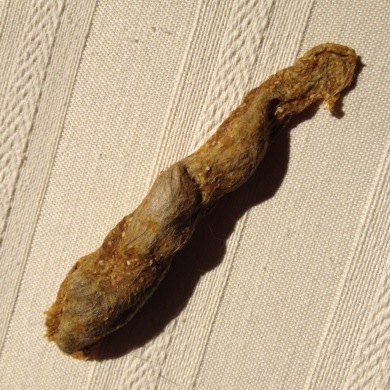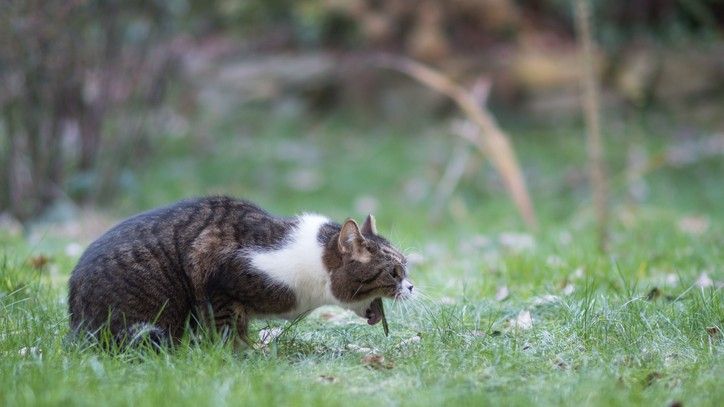No pet parent looks forward to walking in on their adorable kitty gagging and retching then throwing up a hairball.
Yet, for many cat owners, this happens at least once in the lifetime of their kitties.
The unlucky ones experience the phenomenon a few times a year. This is mostly the case for long-haired felines but short-haired beauties can vomit hairballs frequently as well.
Hairballs are disgusting to watch and clean up. Whether your kitty throws up on your kitchen floor or the prized Turkish rug, removing the mess takes a lot on your part.
Most importantly, though, the unpleasant excretion can be a hazard to your sweet pooch.
Hairballs that look like poop can make you go nuts. Surely they must signify that your pooch is terribly sick and needs to see the vet.
Or, are they harmless and no cause for concern? We help you understand more about poop-like hairballs down below.
What Are Hairballs?
In case you are not used to the term ‘hairballs”, how about a quick lesson on the same?
Feline experts refer to them as Trichobezoars which is a Greek word meaning a mass found in the intestines or the stomach.
In layman’s language, a hairball is a clump of ingested hair that makes its way to the digestive tract.
Cats are notorious for ingesting lots of hair, thanks to their meticulous grooming habits.
As they run their tongues over their skin, loose fur is pushed into the mouth.
A cat’s tongue is rough and barbed with the spikes facing backward. As the hair is caught in the mouth, the shape of the tongue makes it easy for the material to slide down the throat and into the gut.
Cat Hairball Looks Like Poop

The word ‘hairball’ gives the assumption of a round-shaped substance. However, hairballs are not round but tubular.
According to Richard Goldstein, Cornell University’s College of Veterinary Medicine’s associate professor of small medicine, they assume this shape as they pass through the thin and hollow feline digestive tract.
In the end, they end up like hair sausages. They are long, tubular, and hollow much like the shape of poop.
The balls are anywhere from 1-5 inches long and one inch thick.
The hairballs are densely packed with nothing but cat hair covered in some disgusting digestive fluid.
Only those that are lodged in the gut will be round like a rolled-up sock or a sponge.
Besides actually assuming the shape of cat poop, trichobezoars also come in the color of feces. This happens when the hair comes in contact with the pet’s food and stomach acids including bile.
Although the hairballs are not digested, they absorb some of the colors and odors of poop.
The ejected material will have some kind of foul but mild odor.
What Is Normal?
Clearly, hairballs and poop have a lot in common –i.e. in terms of looks. They are both long, tubular bundles filled with material.
Of course, one is bulkier and smellier than the other. However, going by physical appearance alone, hairballs do appear as poop.
When you come across one with this very shape, don’t worry. This is absolutely normal.
Apart from having the appearance of feces, hairballs can be somewhat smelly. Nothing should worry you at this point.
When Should You Worry?

Swallowing fur is a common thing in the feline world. As your kitty grooms herself non-stop, she will ingest lots of loose hair in the process.
More often than not, the loose hairs pass down the gut and are eliminated with fecal matter.
However, some hairballs can remain trapped in the tract and cause major intestinal blockage. This is also true when the throwing up of the unpleasant matter becomes too common.
Hence with cat hairballs, the frequency is much more important as opposed to their appearance.
If your sweet fur baby’s gagging and vomiting aren’t regular and the cat seems pretty much healthy, there’s no reason to get concerned—once a month or once a year is generally considered normal.
However, in the case that your kitty is always getting rid of hairballs through her mouth, action must be taken.
Trapped matter can cause great harm for the kitty. At best, it will cause discomfort and a reduced appetite.
At worst, the poor pet can have a serious blockage that needs surgical intervention. This happens when the wad of matter becomes too large and stays in the gut for a longer period of time. Without surgery, the cat may not be around for too long.
Sometimes the hairball is too hard that even if the cat tries to vomit it, she may hurt her esophagus.
You can tell that your kitty is having trouble with hairballs if she’s gasping for air, being lethargic, having a nasal discharge, suffering from diarrhea or constipation, and having a nasal discharge.
What to Do
If you notice the above symptoms along with frequent hairballs, rush the cat to the vet.
She may need help pushing the matter out of her system. Meanwhile, you may want to try out the following preventive strategies for the future:
- Offer A High-Fiber Diet: A lack of dietary fiber can cause a cat to produce regular hairballs. Fiber helps push hair through the gut thus preventing the formation of hairballs. Give the kitty beet pulp, sugarcane fiber, and cellulose to remove hairballs.
- Frequent but Small Meals: The feline system empties well if provided with small but regular meals rather than a few big ones.
- Laxative: This eases the passage of trichobezoar through the digestive tract. Pet stores sell hairball lubricants with healthy gut flora, vegetable oils, bioMOS, and more. Get the approval of your vet and rush to the store.
- Stool Softeners: Olive oil, leafy greens, pumpkin, and oily fish are great natural stool softeners that encourage wad matter to pass.
Final Thoughts
Cat hairballs, in their natural state, look like poop. There’s no reason to panic because of the unpleasant appearance.
As long as the cat acts and looks healthy and the hairballs are rare, keep your cool.
Only contact the vet if the occurrences become too common accompanied by symptoms of pain and discomfort.

Hi! I am Eleanor Price. I started this website after my cat, Louie, almost died from a case of botulism (a type of food poisoning often caused by bacteria that grow on food items). Turned out that my cat’s diet was the problem. I have made it my duty to provide the best information and recommendations about everything cat lovers need to know about their felines’ health and wellbeing. My goal is to find the most informative content on anything feline-related and share it with fellow hardworking kitty lovers.

